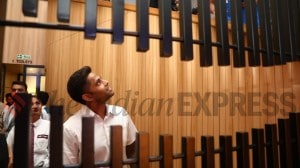Courting the Cauvery controversy
A lawyer with even a limited foresight can suggest that the present round of intervention by the Supreme Court on the Cauvery waters dispute...

A lawyer with even a limited foresight can suggest that the present round of intervention by the Supreme Court on the Cauvery waters dispute leading to a contempt petition against the Karnataka CM, would have two results.
One, that the contempt petition would not translate into strict judicial strictures against the CM. Two, more significantly, it will harden already polarised positions in the two states. The political context of the dispute, where conflicts of interest are camouflaged as conflicts on facts, has made a mockery of the policy requirements that a ‘national perspective’ demands.
Today, national interest is being subsumed by the political interest of the disputant states in this case. Subjecting the political interest to the judicial interest — a result of the untimely knocking of the court’s door by Tamil Nadu — may not be in national interest. This is so for two reasons.
First, inter-state river disputes are hard cases for the judiciary and hard cases provide for bad law. The fervent plea for the kuruvai — and now samba — crop cultivation of Tamil Nadu farmers is apparently as well-founded in the judicial eye as Karnataka’s concern for its drought-stricken farmers.
The outcome in such cases is either a discernible judicial defensiveness leading to long pendancy in court or going back to the executive to help with the details. The court thus had to fall back on the Cauvery River Authority (CRA) — a body that was boycotted by the TN chief minister before approaching the court.
Inevitably in such cases, the courts are less a conflict-resolving and more a forum for a hard-hitting display of stubborn positions.
The other major reason against the court’s role is that any settlement by mutual negotiations cannot go hand-in-hand with judicial intervention. The two processes require two different languages.
One requires compromise and understatements, the other forces confrontation and overstatements. Yet in the Cauvery case the issues are being thrashed out by the CRA and the Cauvery Monitoring Committee (CMC) under the court’s supervision.
Contrary to the first impression that this might be hastening the process of dispute resolution, it is actually hindering it. It provides space for the favourite ‘sub-judice’ argument, which helps Tamil Nadu to prevent CMC from getting at the facts and suggest with a veiled threat that this would be tantamount to contempt of the apex court as it is seized of the matter.
Even where the meetings under CRA has been convened forcibly under the court’s directives, they are seen as the necessary steps for further court interventions.
The problem with the legal language notwithstanding, it has to be conceded that the intervention of the court in all such inter-state water disputes is only going to increase. Over a decade back, on one of the earlier rounds of the court’s intervention on the Cauvery dispute, the apex court ruled that despite the provision in the Inter State Water Disputes Act 1956 barring judicial review of such disputes, the court is the ‘ultimate interpreter of the Act and this general power of the Court cannot be taken away by a Statutory Provision’ (AIR 1992SC 522). Another factor behind the ever expanding judicial review in such disputes is that inter-state water disputes are ultimately disputes over access of people to river waters. As access to water is now settling in as part of our fundamental rights jurisprudence, legal arguments in future will increasingly invoke the fundamental rights of the people getting directly compromised in inter-state water disputes.
And when it comes to fundamental rights, judicial review has no limitation whatsoever. However, the point is that even though such cases represent valid legal claims before the court, there must be sustained effort to preempt such litigation. These issues are best sorted outside the court.
The shorter way of adjudication — a symptom of an increasing political tendency of pushing controversial issues into the judicial arena — is a poor substitute for the longer, tiresome way of continuous negotiations.
However, result-oriented, meaningful negotiations require a framework. An institutional framework for river basin planning was created way back in 1956 by the River Boards Act. It is another matter that not a single river board has been constituted under it till date.
In a recent study, a former minister of water resources of Gujarat has pointed out that the disputes over river waters which were settled in the past were all characterised by specificity and well-defined parameters. It is tragic that such parameters based on equitable distress sharing has not been developed and accepted in the case of the Cauvery waters. The hammer of a judge and the sword of contempt are not exactly the right instruments to evolve such parameters.






- 01
- 02
- 03
- 04
- 05

























